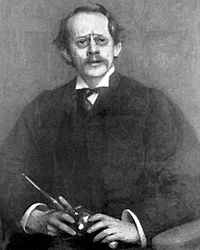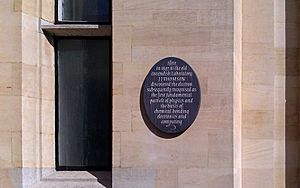J. J. Thomson facts for kids
Quick facts for kids
J. J. Thomson
|
|
|---|---|

Sir Joseph John Thomson (1856-1940)
|
|
| Born | 18 December 1856 |
| Died | 30 August 1940 (aged 83) |
| Nationality | British |
| Alma mater | University of Manchester University of Cambridge |
| Known for | Plum pudding model Discovery of electron Discovery of isotopes Mass spectrometer invention First m/e measurement Proposed first waveguide Thomson scattering Thomson (unit) |
| Awards | Nobel Prize for Physics (1906) |
| Scientific career | |
| Fields | Physics |
| Institutions | Cambridge University |
| Academic advisors | John Strutt (Rayleigh) |
| Notable students | Ernest Rutherford Francis William Aston J. Robert Oppenheimer William Henry Bragg Max Born T. H. Laby Paul Langevin Balthasar van der Pol |
| Signature | |
 |
|
| Notes | |
|
Thomson is the father of Nobel laureate George Paget Thomson.
|
|
Sir Joseph John Thomson (born 18 December 1856 – died 30 August 1940) was a famous English physicist. He is best known for discovering the electron in 1897. The electron was the very first subatomic particle ever found.
Thomson showed that cathode rays were made of tiny, negatively charged particles. He figured out these particles were much smaller than atoms. He also found the first proof of isotopes in 1913. Isotopes are different forms of the same element. His work on positively charged particles helped create the mass spectrograph. This tool helps scientists study atoms and molecules.
In 1906, Thomson won the Nobel Prize in Physics. He received it for his important work on how electricity moves through gases.
Contents
Early Life and Schooling
Joseph John Thomson was born on 18 December 1856. His hometown was Cheetham Hill in Manchester, England. His mother, Emma Swindells, came from a family that worked with textiles. His father, Joseph James Thomson, owned a bookshop. Joseph also had a younger brother named Frederick.
Even as a child, J. J. Thomson showed great talent in science. He went to small private schools. At just 14 years old, in 1870, he started at Owens College in Manchester. His parents wanted him to become an engineer. However, his father passed away in 1873, changing these plans.
In 1876, he moved to Trinity College, Cambridge. He earned his first degree in mathematics in 1880. He became a Fellow of Trinity College in 1881. By 1883, he had earned his Master of Arts degree.
Career and Major Discoveries
On 22 December 1884, Thomson became the Cavendish Professor of Physics at the University of Cambridge. This was a big surprise because he was younger than other candidates. He was known more for his math skills than for lab work.
Nobel Prize and Honors
Thomson received the Nobel Prize in 1906. The award was for his studies on how electricity behaves in gases. He was made a knight in 1908. This meant he could use "Sir" before his name. In 1912, he joined the Order of Merit, a special honor.
In 1918, he became the Master of Trinity College. He stayed there until he died. Joseph John Thomson passed away on 30 August 1940. His ashes are buried in Westminster Abbey. He rests near Sir Isaac Newton and his former student, Ernest Rutherford.
A Great Teacher
One of Thomson's biggest impacts was as an amazing teacher. Many of his students became famous scientists. His student, Ernest Rutherford, later took over his role as Cavendish Professor.
Six of Thomson's research assistants also won Nobel Prizes in physics. These included Niels Bohr and William Henry Bragg. Two others, Francis William Aston and Ernest Rutherford, won Nobel Prizes in chemistry. Even Thomson's own son, George Paget Thomson, won a Nobel Prize in physics in 1937. His son proved that electrons can act like waves.
Other Scientific Work
Thomson wrote many papers about electromagnetism. He studied James Clerk Maxwell's ideas about light. He also suggested that a moving charged particle could appear to gain mass.
In 1905, Thomson found that potassium was naturally radioactive. In 1906, he showed that each hydrogen atom has only one electron. Before this, scientists thought atoms could have different numbers of electrons.
Today, a unit called the "thomson" (Th) is used in mass spectrometry. It measures the mass-to-charge ratio of particles. This unit is named in his honor.
A road on the University of Cambridge campus is named J J Thomson Avenue. In 1927, he opened the Thomson building at The Leys School in Cambridge.
Awards and Recognitions
Thomson was chosen as a Fellow of the Royal Society in 1884. He also became the Cavendish Professor of Experimental Physics at the Cavendish Laboratory. He received many awards during his career:
- Adams Prize (1882)
- Royal Medal (1894)
- Hughes Medal (1902)
- Hodgkins Medal (1902)
- Nobel Prize for Physics (1906)
- Elliott Cresson Medal (1910)
- Copley Medal (1914)
- Franklin Medal (1922)
He was also the President of the Royal Society from 1915 to 1920.
Images for kids
See also
 In Spanish: Joseph John Thomson para niños
In Spanish: Joseph John Thomson para niños






